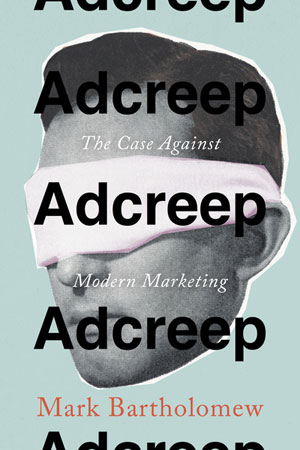
By some counts, the average American is exposed to over three thousand advertisements each day. It is not just the number, but the nature of these ads that are different from those in the past. They are more personalized, more insistent, and, somewhat paradoxically, more clandestine. What does it mean to live in a world of non-stop selling? Are consumers adequately equipped to deal with modern marketing’s use of new technologies to surveil our activities, study our brains, and score our social interactions? Are there costs to this fundamental rebalancing of the relationship between advertiser and audience? If so, why hasn’t there been more resistance on the part of lawmakers and the general public?
Adcreep exposes the initiatives that advertisers try to keep hidden. Each chapter in the book describes a new advertising technique and its accompanying social dangers. Advances in neuroscience have become a tool for subconsciously stimulating shoppers’ appetites. Corporate infiltration of schools, state parks, and other civic territories alters the way identities are formed so as to best suit Madison Avenue. A world of non-stop digital surveillance leaves consumers open to blackmail and discrimination. Celebrity advertising on social media creates a false equivalence: the famous possess special VIP tools to manage online disclosures while ordinary citizens must forfeit control of their posts to false friends, hostile outsiders, and data-hungry marketers.
This is a book that should especially appeal to readers with an interest in history. To explain why advertisers have been allowed to proceed with these new selling techniques, it helps to have a historical backdrop in mind.
Past controversies over invasive advertising strategies triggered a series of legal battles, ultimately producing a regulatory framework meant to keep business freedom and consumer protection in balance. The book describes this regulatory framework, and uses historical examples to show how it has dealt over time with a variety of advertising innovations. Disputes over billboard regulation, snake oil salesmen, subliminal advertising, and the use of digital technology to reanimate dead celebrities are all instructive examples. They illustrate how the new advertising techniques of today echo the forbidden techniques of the past.
The book’s ultimate conclusion is that, on a variety of fronts, the legal system is allowing invasive advertising to proceed unchecked. Novel interpretations of the First Amendment, contract law, intellectual property law, and the publicity rights of celebrities all handcuff fledgling efforts to adjust the law to account for commercial innovation.
By the end of the book, readers should be convinced of two things. One is that modern marketing has entered a new, profoundly different era. The other is that, in contrast to the past, lawmakers have done little to safeguard consumers from adcreep.
Given its nearly ubiquitous presence in our lives, advertising is one of the most important economic and social drivers in American society. Yet its sheer ubiquity lulls us into complacency. When no space is off-limits to commercial appeals, we become numb to the ideology of advertising.
That was my experience. I went about my daily life, not really noticing the commercial forces constantly whispering in my ear. Then two things happened.
I was teaching intellectual property and privacy law at a law school. I came to realize that the latest developments in those fields often centered on new advertising technologies. In recent years, companies trying to cement their informational advantages over consumers propelled big changes in First Amendment law, privacy law, and trademark law. These changes benefited businesses, not consumers.
I also had children. To the extent that I thought about the commercials all around me, I thought I could handle them. Sure, sometimes advertisers stretched the truth or appealed to my emotions. I assumed, however, that I, myself, and other consumers could rationally evaluate advertising’s messages, and adequately discount their non-informational aspects.
Then my kids became subject to their own torrent of commercial appeals. Of course, I tried to screen some ads from their field of vision. But advertising in the modern age is inescapable. My kids repeated the messages they heard through the car radio and saw when they rode mass transit. They expressed both interest and annoyance at the constant requests to click on online ads, even when they were using school-approved apps and websites. After this, I became less sanguine about my own capability for resistance, realizing that my best efforts to shield my kids had failed. Over time, relentless product proselytizing takes a toll on anyone, child or adult.
To really appreciate the consequences of advertising’s expansion, we need to understand how the process works. One of the central questions about advertising is its relationship to consumer agency. If advertising simply offers opportunities that consumers are free to accept or reject, then its presence in new spaces becomes less objectionable. If it exercises significant influence over its audiences, then advertising’s spread becomes cause for concern.
So how do the power dynamics of advertising expansion work? The French philosopher Michel Foucault distinguished between disciplinary power and direct punishment. In a historical shift, he argued, authorities moved away from social control through brute force to using techniques that allowed them to govern their subjects without their awareness.
Modern advertising uses these same disciplinary techniques. By monitoring and shaping the expressive content found in particular territories, advertisers project norms for others to follow. They also suggest the “abnormal” behavior audiences should avoid.
Ultimately, advertising’s advance into new territories is a project of governance, meant to monitor, inform, and persuade. Even acknowledging that consumers resist and reconfigure many marketing messages, there is little doubt that advertising shapes our sense of self while masking its own ability to do so.
Chapter 4, “From Market Share to Mindshare,” is about the new discipline of neuromarketing. The ability to monitor consumers’ biological responses to commercials in real time has led to more effective advertising, but that’s not necessarily a good thing.
Neuromarketing combines emerging insights from neuroscience with the study of consumer behavior. By allowing purchasing motivations to be probed without conscious participation, neuromarketing threatens to reveal and activate inner prejudices that consumers might prefer to keep from view.
A good example is a recent ad campaign for Cheetos. Frito-Lay used the findings of a neuromarketing firm to develop a series of commercials that revolved around acts of vandalism and antisocial behavior, all egged on by the Cheetos mascot. In one ad, the protagonist used the orange snack food to ruin another person’s dryer load of white laundry. In another, a cheese puff is nihilistically mashed into the keyboard of a tidy coworker.
When directly asked, test audiences said that they did not like the ads. An industry commentator described the campaign as “cynical and disgusting.” But Frito-Lay believed that brain scans of prospective Cheetos eaters told a different story. They proceeded with the ads, and credited them with a significant increase in Cheetos sales.
One might shrug off this particular campaign as just an effort to make us laugh. But the key thing to note is that neuromarketing disdains conscious, considered audience feedback in favor of involuntary, biological responses. With brain scans, consumers don’t have a way to screen undesirable or socially unacceptable emotional reactions from marketers. One can envision other campaigns based on neurological data that celebrate some of our worst impulses, ones that we can normally avoid communicating to the outside world.
This isn’t the first time advertisers have threatened to read our minds. In the 1950s, there was a scandal over subliminal advertising. Both government and private regulators reacted swiftly to the prospect of subliminal ads. In the midst of the Cold War, they were concerned about Madison Avenue installing its own Manchurian candidates in the grocery story aisle.
By contrast, today’s neuromarketing techniques are completely unregulated. Likely candidates for restraining the neuromarketers—the Federal Trade Commission and institutional review boards—have abdicated their supervisory role.
Neuroscience offers some wonderful possibilities. In time, fact-finders may be able to assess and compensate pain and suffering in personal injury cases with more accuracy. Neural evidence of the drivers of criminal behavior may counsel different, more humane understandings of criminal responsibility.
But neuroscience, when leveraged in service of commercial appeals, also has the potential to subvert democratic values and aid discriminatory impulses. Long before neural scanning was possible, advertisers came under fire for ad campaigns insensitive to race, gender, and sexual identity. In the absence of an actual dialogue with consumers, there is an even greater likelihood that marketers will tailor their messages to some of our worst, most intolerant instincts.
An intricate ecosystem of laws, regulatory agencies, legal actors, and social and cultural norms exist to determine advertising’s proper role. A series of historical battles over marketing innovations formed this ecosystem. What this book suggests is that the ecosystem has remained static when it needs to dynamically respond to a series of new technological threats.
There are no simple solutions to the dangers of adcreep. Concerns over the cognitive abilities of consumers, the competence of government regulators, and the professional ethics of advertisers make resolution of these issues difficult and complex. As the legal scholar Arthur Leff said forty years ago, “There is no ‘whole story’ that can be told about anything, especially anything as socially, economically, literarily, anthropologically, philosophically, legally, historically, and politically complex as advertising.”
Nevertheless, the costs of doing nothing are too great. Individually, strategies for surveilling consumers on social media, selling to children in public schools, commandeering public space, and swapping neurological data for conscious dialogue are all concerning. Together, they may fundamentally change the advertiser-consumer relationship.
My hope is that this book causes people to think about advertising more critically. The problem is that the more advertising we are exposed to, the less objectionable it becomes. Advertising’s growing presence numbs onlookers to the techniques of commercial persuasion. It normalizes the individualist and materialist ideologies championed by businesses, threatening to crowd out alternative philosophies of human flourishing. Few ads tell us to shop less or to focus on our civic responsibilities.
Over time, the presence of ads in a particular territory becomes an acceptable part of the environment. Take, for example, pre-film advertising. Commercials before films (aside from previews of coming attractions or requests to visit the theater’s snack stand) are a relatively new phenomenon dating from the early 1990s. Initially, these pre-film ads triggered outrage. Moviegoers howled at them. Lawmakers proposed legislation to stop the practice. But, eventually, the resistance faded. The legislation died in committee. Public outrage became grudging acceptance.
This leads me to believe that the window for action is short. Adcreep argues that we are at a tipping point. The host of invasive marketing techniques described in the book are already changing the environments in which we live. The character of our homes, our schools, and our public spaces hang in the balance. We shouldn’t just let this commercial tide wash over us. We should interrogate these changes. And, when the social costs of these changes seem too great, we should demand that the law halt adcreep’s advance before it’s too late.


Mark Bartholomew is Professor of Law at the University at Buffalo School of Law. He writes and teaches in the areas of intellectual property and law and technology, with an emphasis on advertising regulation, online privacy, copyright, and trademarks. He has provided commentary on these issues in The New York Times, The Washington Post, Los Angeles Times, USA Today, The Wall Street Journal, and other news outlets.